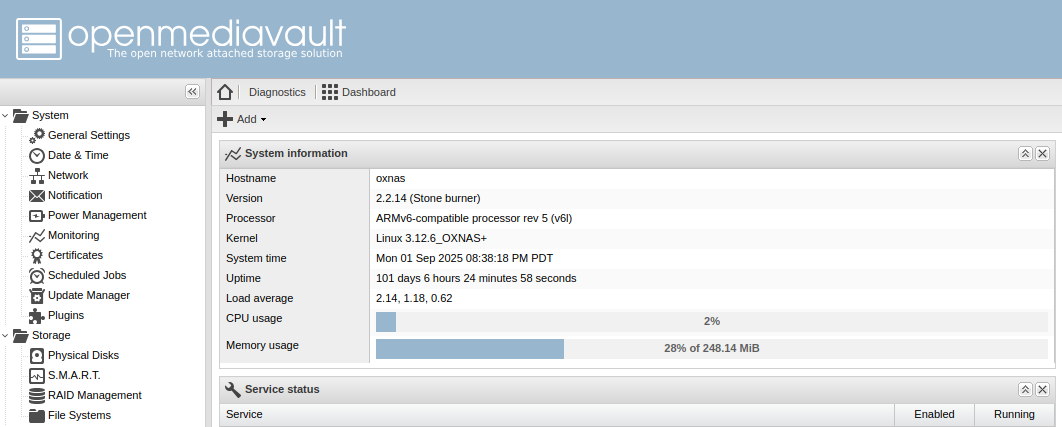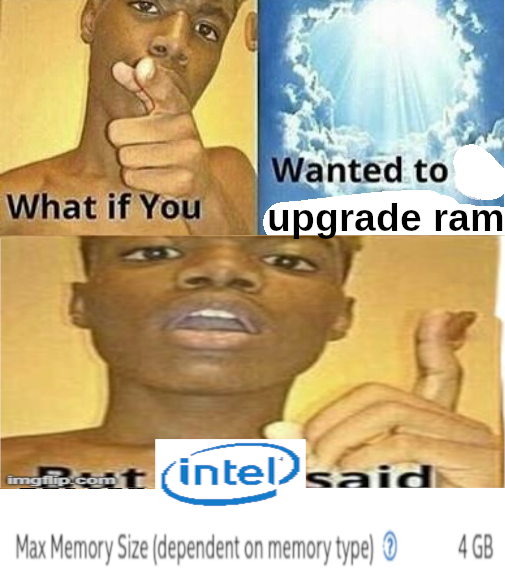7 websites, Jellyfin for 6 people, Nextcloud, CRM for work, email server for 3 domains, NAS, and probably some stuff I've forgotten on a $4 computer from a tiny thrift store in BFE Kansas. I'd love to upgrade, but I'm always just filled with joy whenever I think of that little guy just chugging along.
Selfhosted
A place to share alternatives to popular online services that can be self-hosted without giving up privacy or locking you into a service you don't control.
Rules:
-
Be civil: we're here to support and learn from one another. Insults won't be tolerated. Flame wars are frowned upon.
-
No spam posting.
-
Posts have to be centered around self-hosting. There are other communities for discussing hardware or home computing. If it's not obvious why your post topic revolves around selfhosting, please include details to make it clear.
-
Don't duplicate the full text of your blog or github here. Just post the link for folks to click.
-
Submission headline should match the article title (don’t cherry-pick information from the title to fit your agenda).
-
No trolling.
Resources:
- selfh.st Newsletter and index of selfhosted software and apps
- awesome-selfhosted software
- awesome-sysadmin resources
- Self-Hosted Podcast from Jupiter Broadcasting
Any issues on the community? Report it using the report flag.
Questions? DM the mods!
Hell yeah, keep chugging little guy 🤘
Heck yeah
Which CRM please?
EspoCRM. I really like it for my purposes. I manage a CiviCRM instance for another job that needs more customization, but for basic needs, I find espo to be beautiful, simple, and performant.
Interested in how it does jellyfin, decent GPU or something else?
It does fine. It's an i5-6500 running CPU transcoding only. Handles 2-3 concurrent 1080p streams just fine. Sometimes there's a little buffering if there's transcoding going on. I try to keep my files at 1080p for storage reasons though. This thing's not going to handle 4k transcoding very well, but it does okay if you don't expect too much from it.
Just down load more ram capacity. It the button right under the down load more ram button.
People in this thread have very interesting ideas of what "shit hardware" is
My cluster ranges from 4th gen to 8th gen Intel stuff. 8th gen is the newest I've ever had (until I built a 5800X3D PC).
I've seen people claiming 9th gen is "ancient". Like...ok moneybags.
My 9th gen intel is still not the bottleneck of my 120hz 4K/AI rig, not by a longshot.
I was for a while. Hosted a LOT of stuff on an i5-4690K overclocked to hell and back. It did its job great until I replaced it.
Now my servers don't lag anymore.
EDIT: CPU usage was almost always at max. I was just redlining that thing for ~3 years. Cooling was a beefy Noctua air cooler so it stayed at ~60 C. An absolute power house.
Maybe not shit, but exotic at that time, year 2012.
The first Raspberry Pi, model B 512 MB RAM, with an external 40 GB 3.5" HDD connected to USB 2.0.
It was running ARM Arch BTW.

Next, cheap, second hand mini desktop Asus Eee Box.
32 bit Intel Atom like N270, max. 1 GB RAM DDR2 I think.
Real metal under the plastic shell.
Could even run without active cooling (I broke a fan connector).
What're you hosting on them?
Mainly telemetry, like temperature inside, outside.
Script to read a data and push it into a RRD, later PostreSQL.
ligthttpd to serve static content, later PHP.
Once it served as a bridge, between LAN and LTE USB modem.
I have one of these that I use for Pi-hole. I bought it as soon as they were available. Didn't realise it was 2012, seemed earlier than that.
4 gigs of RAM is enough to host many singular projects - your own backup server or VPN for instance. It's only if you want to do many things simultaneously that things get slow.
It is amazing what you can do with so little. My server has nas, jellyfin, plex, ebook reader, recipe, vpn, notes, music server, backups, and serves 4 people. If it hits 4gb ram usage it is a rare day.
I'm sure a lot of people's self hosting journey started on junk hardware... "try it out", followed by "oh this is cool" followed by "omg I could do this, that and that" followed by dumping that hand-me-down garbage hardware you were using for something new and shiny specifically for the server.
My unRAID journey was this exactly. I now have a 12 hot/swap bay rack mounted case, with a Ryzan 9 multi core, ECC ram, but it started out with my 'old' PC with a few old/small HDDs
Maybe a more reasonable question: Is there anyone here self-hosting on non-shit hardware? 😅
I'm happy with my little N100
Rehabilitated HP z440 workstation, checking in! Popped in a used $20 e5-2620v4 xeon CPU and 64gb of RAM and it sails for my use cases. TrueNAS as the base OS and a TalOS k8's cluster in a VM to handle apps. Old but gold.
Enterprise level hardware costs a lot, is noisy and needs a dedicated server room, old laptops cost nothing.
I got a 1U rack server for free from a local business that was upgrading their entire fleet. Would've been e-waste otherwise, so they were happy to dump it off on me. I was excited to experiment with it.
Until I got it home and found out it was as loud as a vacuum cleaner with all those fans. Oh, god no...
I was living with my parents at the time, and they had a basement I could stick it in where its noise pollution was minimal. I mounted it up to a LackRack.
Since moving out to a 1 bedroom apartment, I haven't booted it. It's just a 70 pound coffee table now. :/
I had a old Acer SFF desktop machine (circa 2009) with an AMD Athlon II 435 X3 (equivalent to the Intel Core i3-560) with a 95W TDP, 4 GB of DDR2 RAM, and 2 1TB hard drives running in RAID 0 (both HDDs had over 30k hours by the time I put it in). The clunker consumed 50W at idle. I planned on running it into the ground so I could finally send it off to a computer recycler without guilt.
I thought it was nearing death anyways, since the power button only worked if the computer was flipped upside down. I have no idea why this was the case, the computer would keep running normally afterwards once turned right side up.
The thing would not die. I used it as a dummy machine to run one-off scripts I wrote, a seedbox that would seed new Linux ISOs as it was released (genuinely, it was RAID0 and I wouldn't have downloaded anything useful), a Tor Relay and at one point, a script to just endlessly download Linux ISOs overnight to measure bandwidth over the Chinanet backbone.
It was a terrible machine by 2023, but I found I used it the most because it was my playground for all the dumb things that I wouldn't subject my regular home production environments to. Finally recycled it last year, after 5 years of use, when it became apparent it wasn't going to die and far better USFF 1L Tiny PC machines (i5-6500T CPUs) were going on eBay for $60. The power usage and wasted heat of an ancient 95W TDP CPU just couldn't justify its continued operation.
You can do quite a bit with 4GB RAM. A lot of people use VPSes with 4GB (or less) RAM for web hosting, small database servers, backups, etc. Big providers like DigitalOcean tend to have 1GB RAM in their lowest plans.
I run a local LLM on my gaming computer thats like a decade old now with an old 1070ti 8GB VRAM card. It does a good job running mistral small 22B at 3t/s which I think is pretty good. But any tech enthusiast into LLMs look at those numbers and probably wonder how I can stand such a slow token speed. I look at their multi card data center racks with 5x 4090s and wonder how the hell they can afford it.
your hardware ain't shit until it's a first gen core2duo in a random Dell office PC and 2gb of memory that you specifically only use just because it's a cheaper way to get x86 when you can't use your raspberry pi.
Also they lie most of the time and it may technically run fine on more memory, especially if it's older when dimm capacities were a lot lower than they can be now. It just won't be "supported".
Does this count ARMv6 256MB RAM running OpenMediaVault...hmm I have to fix my clock. LOL

3x Intel NUC 6th gen i5 (2 cores) 32gb RAM. Proxmox cluster with ceph.
I just ignored the limitation and tried with a single sodim of 32gb once (out of a laptop) and it worked fine, but just backed to 2x16gb dimms since the limit was still 2core of CPU. Lol.
Running that cluster 7 or so years now since I bought them new.
I suggest only running off shit tier since three nodes gives redundancy and enough performance. I've run entire proof of concepts for clients off them. Dual domain controllers and FC Rd gateway broker session hosts fxlogic etc. Back when Ms only just bought that tech. Meanwhile my home "ARR" just plugs on in docker containers. Even my opnsense router is virtual running on them. Just get a proper managed switch and take in the internet onto a vlan into the guest vm on a separate virtual NIC.
Point is, it's still capable today.
I started my self hosting journey on a Dell all-in-one PC with 4 GB RAM, 500 GB hard drive, and Intel Pentium, running Proxmox, Nextcloud, and I think Home Assistant. I upgraded it eventually, now I'm on a build with Ryzen 3600, 32 GB RAM, 2 TB SSD, and 4x4 TB HDD
I've got a i3-10100, 16gb ram, and an unused gtx 960. It's terrible but its amazing at the same time. I built it as a gaming pc then quit gaming.
10th gen is hardly "shit hardware".
That's a pretty solid machine
7th gen intel, 96GB mismatched ram, 4 used 10TB HDD, one 12 with a broken sata connector that only works because it's sitting just right in a sled. A couple of 14's one M.2 and two sataSSD. It's running Unraid with 2 VM's (plex and Home Assistant), one of which has corrupted itself 3 times. A 1080 and a 2070.
I can get several streams off it at once, but not while it's running parity check and it can't handle 4k transcoding.
It's not horrible, but I couldn't do what I do now with less :)
Yup. Gateway E-475M. It has trouble transcoding some plex streams, but it keeps chugging along. $5 well spent.
it can do it!
... just not today
got a ripping and converting pc that ain't any better. it's all it does, so speed don't matter any. hb has queue, so nbd. i just let it go... and go... and go...

